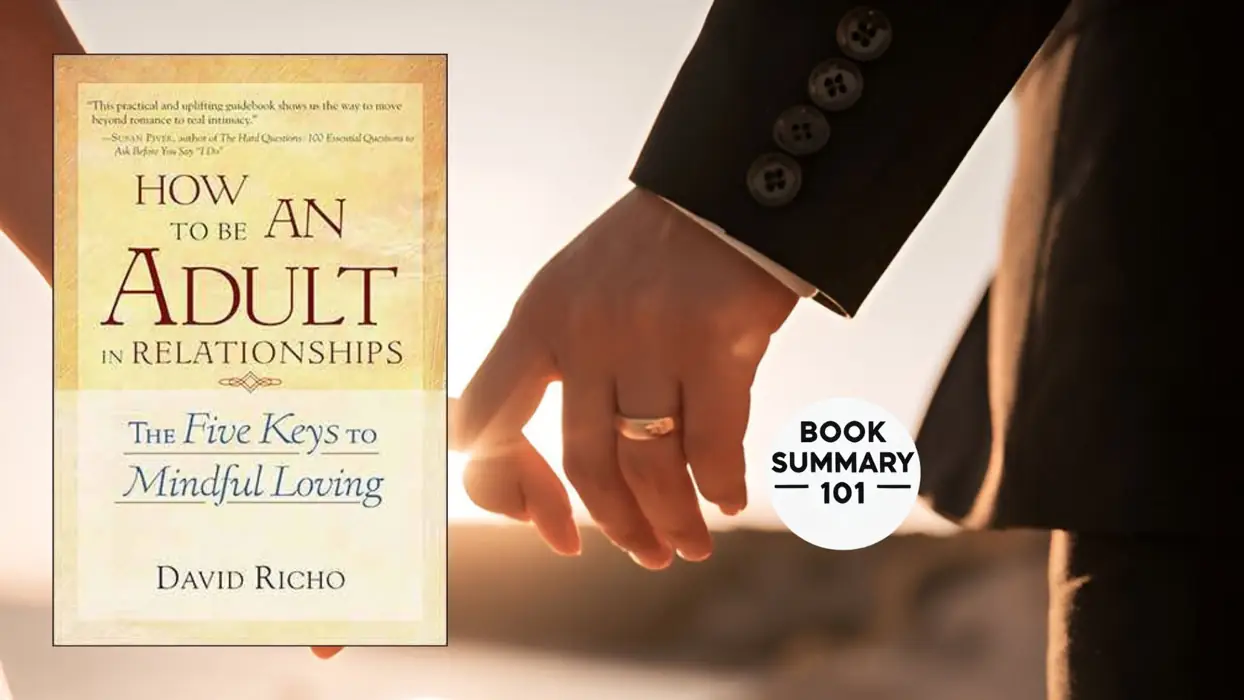Have you ever wondered why relationships can feel so hard, even when love is clearly there? Why do misunderstandings and unmet needs creep in, even with the best intentions? David Richo’s How to Be an Adult in Relationships: The Five Keys to Mindful Loving answers these questions with compassion, wisdom, and practical tools.
Richo breaks down what it means to truly love—not in the romanticized way we see in movies, but in a mature, mindful, and deeply fulfilling way. If you’re ready to level up your relationships, let’s explore his five transformative keys to mindful loving and how they can create lasting change in your life.
Let’s dive into the big stepes and why this book might just change how you approach love forever.
Why Read This Book?
If relationships often leave you feeling frustrated, disconnected, or confused, you’re not alone. Most of us weren’t taught how to love well. Richo’s book acts as a guide, combining psychology, spirituality, and real-world advice to help you:
- Build deeper connections with your partner.
- Navigate conflict with grace instead of defensiveness.
- Break free from childhood patterns that no longer serve you.
Richo isn’t just about offering fluffy advice. He breaks down love into actionable steps while respecting its emotional and spiritual depth. It’s therapy in book form!
The book on amazon 👉 How to Be an Adult in Relationships 📚
The 5 Keys to Mindful Loving: A Detailed Guide to Deepening Your Relationships
David Richo’s How to Be an Adult in Relationships highlights five transformative keys to mindful loving that can help us create relationships rooted in mutual respect, understanding, and deep emotional connection. These keys—attention, acceptance, appreciation, affection, and allowing—act as a framework for cultivating love that is mature and fulfilling.
Let’s take a closer, more detailed look at each key, complete with examples to bring these principles to life.
1. Attention: Show Up Fully
Attention is the cornerstone of mindful loving. It’s not just about physically being in the same space; it’s about truly showing up. When you give your partner your full attention, you’re saying, “You matter to me. I see you. I hear you.”
Richo emphasizes the importance of being present without distractions, especially in a world filled with noise—from endless notifications to the stress of daily life. Genuine attention nurtures emotional intimacy and builds trust over time.
What This Looks Like:
- Actively listening during conversations instead of multitasking.
- Observing subtle cues in your partner’s mood or behavior and checking in with them.
- Prioritizing quality time, even if it’s just 15 minutes of undivided focus each day.
Real-Life Example:
You’ve had a terrible day at work and need to vent. If your partner stays glued to their phone, offering a distracted “uh-huh,” it can feel dismissive and invalidating. But imagine a different scenario: your partner puts their phone down, maintains eye contact, and asks, “That sounds rough—do you want to talk about it?”
The second response fosters connection and reassures you that your feelings matter. Richo urges us to be fully present, like the second partner, to strengthen emotional bonds.
2. Acceptance: Love Them as They Are
Acceptance means embracing your partner’s true self—flaws, quirks, and all—without trying to mold them into your ideal version. It’s about understanding that no one is perfect and that love grows when we feel accepted for who we are.
Acceptance, however, doesn’t mean ignoring unhealthy behaviors or settling for less than you deserve. It’s about striking a balance between holding space for your partner’s individuality and fostering mutual growth.
What This Looks Like:
- Letting go of unrealistic expectations or comparisons to past relationships.
- Supporting your partner’s unique preferences, even when they differ from yours.
- Addressing issues constructively without shaming or blaming.
Real-Life Example:
Your partner is obsessed with cheesy rom-coms, while you’re a die-hard thriller fan. Instead of rolling your eyes or dismissing their movie picks as “silly,” you join them for a rom-com night and even laugh at the predictable plot. By embracing their interests, you’re showing acceptance and love for who they are—not who you think they should be.
Acceptance isn’t about agreeing on everything; it’s about respecting and cherishing your differences.
3. Appreciation: Celebrate the Good
Appreciation is the antidote to taking your partner for granted. When we’ve been with someone for a while, it’s easy to focus on what’s missing or what’s going wrong. But consistently noticing and acknowledging the good creates a positive cycle of gratitude and connection.
Richo encourages us to appreciate both the big gestures and the small, everyday actions. A simple “thank you” can go a long way toward making your partner feel valued.
What This Looks Like:
- Complimenting your partner sincerely and often.
- Acknowledging the effort they put into the relationship.
- Finding small ways to say, “I see what you’re doing, and I appreciate it.”
Real-Life Example:
Your partner makes you coffee every morning. It’s become such a routine that you barely notice it anymore. But instead of letting it slip by, you pause one morning and say, “Thanks for always making coffee—it’s such a thoughtful way to start the day.”
Appreciation like this strengthens the relationship, reminding both of you why you fell in love in the first place.
4. Affection: Express Your Love Freely
Affection is love in action. It’s how we show our partner that they’re cherished, not just in grand romantic gestures but in consistent, everyday moments. Affection can be verbal, physical, or through thoughtful acts.
Richo highlights that affection isn’t just about romance; it’s about cultivating a sense of warmth and emotional safety. When affection is freely given, it reassures your partner of your love and commitment.
What This Looks Like:
- Offering regular physical touch, like hugs, kisses, or holding hands.
- Writing a heartfelt note or sending a sweet text during the day.
- Taking the time to ask, “How are you really feeling today?”
Real-Life Example:
Imagine your partner has a big presentation at work. On the morning of their presentation, you leave a sticky note on the fridge that says, “You’re going to crush it today—I believe in you!” This small but meaningful gesture makes them feel loved and supported, setting a positive tone for their day.
Affection doesn’t have to be elaborate. The key is to express it consistently and genuinely.
5. Allowing: Grant Freedom
Allowing is about giving your partner the space to be themselves, pursue their passions, and grow as an individual. This doesn’t mean turning a blind eye to the relationship; it means trusting that love can thrive alongside freedom.
Richo explains that control and love cannot coexist. When we try to control our partner—whether consciously or unconsciously—we create resentment and stifle their growth. Allowing, on the other hand, fosters mutual respect and trust.
What This Looks Like:
- Encouraging your partner to spend time with friends or pursue solo hobbies.
- Supporting their goals and ambitions, even if they don’t align perfectly with yours.
- Trusting your partner’s decisions without micromanaging.
Real-Life Example:
Your partner wants to take a solo weekend trip to recharge and explore a new city. Instead of feeling insecure or trying to convince them to stay home, you encourage their adventure, knowing it’s something they need. When they return, they’re re-energized and grateful for your understanding.
Allowing your partner freedom creates a healthier, more balanced relationship where both people can thrive.
Final Thoughts: Why These Keys Matter
Richo explains that these five keys—attention, acceptance, appreciation, affection, and allowing—are rooted in our deepest emotional needs. When these needs are met, we feel secure and loved. When they’re ignored, resentment and disconnection creep in.
The beauty of these keys is that they don’t just apply to romantic relationships. They can transform how you interact with family, friends, and even yourself.
What Do You Think? Let’s Talk!
Which of these five keys resonates with you the most? Do you find it challenging to show consistent attention, or is allowing your partner freedom a struggle? Or maybe you’ve experienced the power of one of these keys and have a story to share.
Let’s chat in the comments—relationships are a journey, and we’re all in this together. Whether you’re learning to love better or teaching others through your example, your insights matter
Richo’s How to Be an Adult in Relationships isn’t just a book; it’s a guide to loving with intention, maturity, and authenticity. Ready to transform your relationships? Start by embracing these five keys—and watch your connections deepen in ways you never imagined.
So, what’s your next step toward mindful loving? 💛
The book on amazon 👉 How to Be an Adult in Relationships 📚
quotes from How to Be an Adult in Relationships by David Richo:
“Love is not about finding the right person, but about becoming the right person.”
→ True love isn’t about searching for perfection in others—it’s about cultivating emotional maturity within ourselves.
“Mindful loving means showing up with full presence, without trying to control or change our partner.”
→ Love thrives when we allow each other to be fully seen and accepted, rather than forcing someone to fit our expectations.
“The more we accept ourselves, the more we can accept others.”
→ Self-acceptance is the foundation of healthy relationships; without it, we project our insecurities onto our partner.
“Affection is not just an emotion we feel—it’s an action we choose.”
→ Love isn’t passive; it’s a daily practice of showing care through words, touch, and gestures.
“To love someone is to grant them the freedom to be themselves.”
→ Control and true love cannot coexist. When we truly love someone, we respect their autonomy and personal growth.


